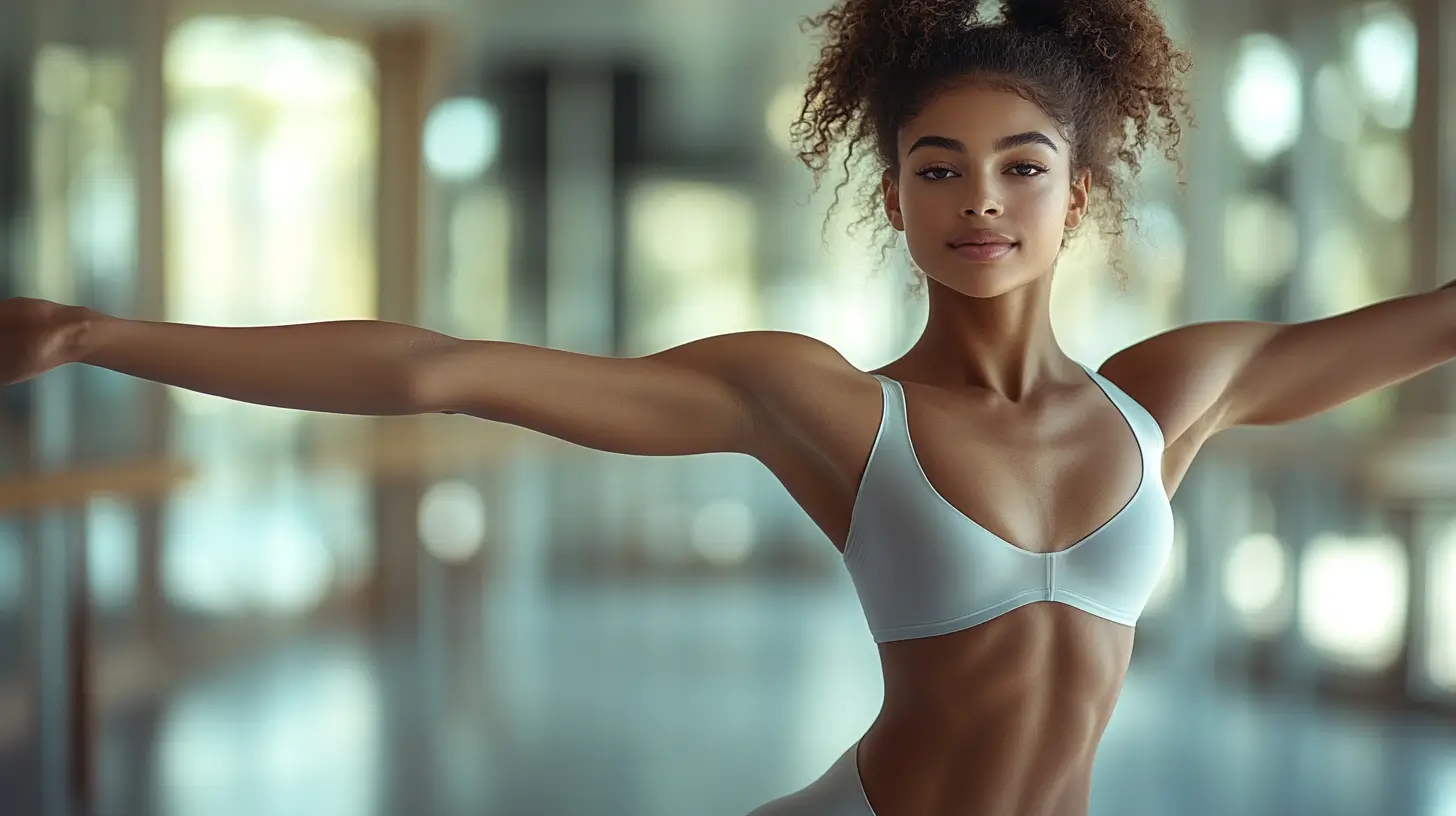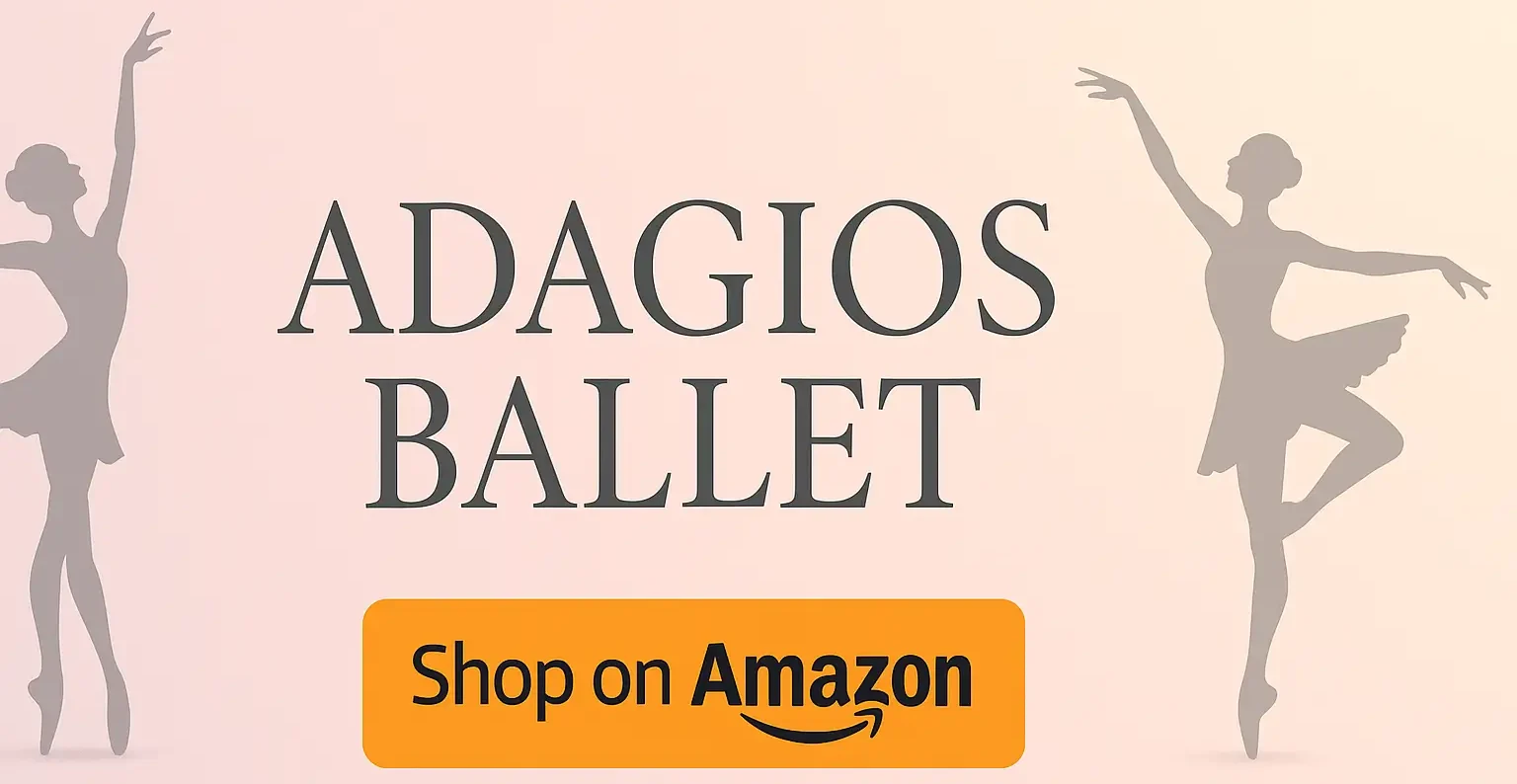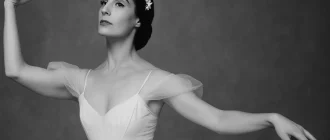Adagio ballet emphasizes slow, controlled movements and steps that showcase balance and grace. This guide will help you master the techniques, steps, and exercises needed for this ballet style.
Graceful Insights
- Adagio ballet focuses on slow, controlled movements emphasizing grace, balance, and technical skill.
- Key techniques for mastering Adagio include building strength in the legs and core and maintaining fluidity and movement control.
- A supportive class environment is crucial for adult learners. It fosters confidence and allows for personal expression during adagio practice.
Art de Podcast
| Aspect | Techniques | Tips | Tricks |
|---|---|---|---|
| Balance | Engage the core, keep the shoulders down, and shift weight smoothly from one foot to another. | Focus on a single point for stability; activate lower abs. | Practice balancing exercises outside Adagio, like holding retire or arabesque for extended periods. |
| Leg Extension | Develop strength and flexibility with regular stretching; lift from the hip with control, avoiding forceful movements. | Focus on controlled, gradual leg lifts to prevent wobbling. | Use resistance bands for added strength; practice with support to improve leg height and control over time. |
| Arm Positioning | Maintain smooth, flowing arm movements; avoid tensing fingers or elbows to achieve graceful transitions. | Practice arm shapes in front of a mirror to ensure fluidity and form. | Visualize arms moving through water for smoother transitions; use light weights to build arm stamina. |
| Slow Movement | Break down each movement; focus on stability and control, using breath to maintain rhythm. | Breathe steadily to support slow, continuous movement. | Count to stay on the beat; build stamina with short intervals of slow practice before adding more complex moves. |
| Transitions | Make transitions seamless by engaging the core and arms; don’t let movements appear jerky or mechanical. | Imagine blending movements as if painting with one continuous stroke. | Visualize smooth pathways; rehearse each part of the transition separately, then combine for fluid movement. |
| Coordination | Synchronize arm and leg movements; practice without mirrors to feel each position. | Start with slow tempos, then increase speed to retain coordination. | Mentally rehearse each sequence; coordinate with counts for better timing and muscle memory. |
| Strength Building | Add exercises like planks and calf raises; practice adagio steps with ankle weights to build strength for slow movements. | Strengthen ankles and feet for better support. | Focus on eccentric muscle movements for controlled strength; integrate Pilates for core stability. |
| Footwork | Ensure pointed feet throughout; lift heels subtly for height and elegance, maintaining control in foot placement. | Regularly stretch and strengthen feet; work on demi-pointe and full-pointe control. | Roll through the foot during steps to enhance fluidity; use toe spacers to practice accurate point alignment. |
| Spatial Awareness | Practice in different areas to adapt to spatial limitations; use the periphery to gauge the surrounding space for better positioning. | Familiarize yourself with the stage dimensions or dance space. | Practice sequences in varying sizes of dance spaces; dance outdoors to boost spatial adaptation. |
| Breathing | Practice breathing techniques aligned with slow movements to avoid rigidity; inhale during preparation and exhale during execution. | Maintain a calm, rhythmic breath pattern; avoid holding your breath. | Pair breath with arm and leg movements; use slow exhalation to control descent in movements. |
Understanding Adagio in Ballet
Adagio in ballet emphasizes slow, controlled movements, allowing dancers to showcase their grace and balance in a mesmerizing and technically challenging way. Derived from the Italian term ‘slowly,’ it focuses on fluidity rather than speed, distinguishing it from other dance forms that may prioritize rhythm or quick movements.
Unlike lyrical ballerina dance, which often emphasizes emotional expression through movement, adagio ballet requires precision and control of traditional ballerina ballet techniques. This focus on sustained, graceful movements allows ballerina dancers to highlight their balance and strength, creating a visually stunning performance that captivates audiences.
Key Techniques for Adagio Ballet
Mastering adagio ballet involves a deep understanding of key techniques that emphasize:
- balance
- control
- fluidity
- grace
The slow tempo of Adagio demands a combination of physical strength and mental discipline to maintain the precision and elegance required for each movement. Strength development enhances balance and fluidity, allowing dancers to perform gracefully and confidently.
Instructors often provide hands-on corrections to help adult ballet learners achieve proper posture and alignment, which are vital for performing adagio movements with the required control. Mastering these foundational techniques, including the closed fourth position for correct alignment, enables dancers to excel in adagio adult ballet.
Balance and Control
Effective balance in Adagio involves adapting to subtle shifts in the body and environment without losing equilibrium. Maintaining a closed fourth position can help balance and control adagio movements.
Maintaining balance during slow movements is crucial, and dancers should avoid using their toes for support to ensure greater control. Core stability plays a significant role in maintaining this balance, with exercises like planks and bridges being vital for improving core strength and stability.
Pilates can greatly improve core stability, aiding in maintaining balance. Enhancing body awareness and refining form help dancers achieve the strength and precision required for adagio movements.
Fluidity and Grace
Adagio’s choreography emphasizes the beauty and fluidity of movement, requiring dancers to maintain a sense of flow and continuity throughout their performance. The exercises involved in Adagio, such as slow, controlled movements, help enhance balance and poise, contributing to a graceful aesthetic.
Completing each movement fully is crucial in Adagio to prevent a rushed appearance and enhance the performance’s overall gracefulness. Concentrating on these elements ensures adagio routines remain fluid and elegant, capturing the lyrical essence of this beautiful dance form.
Choreography for Adagio Ballet

In ballet, this type of lyrical Adagio is often characterized by sustained poses and transitions, allowing dancers to showcase their artistic expression and technical skill. These slower, sustained movements contrast with the more fluid and dynamic movements in lyrical dance, highlighting the strength and balance required for lyrical Adagio.
Smooth transitions are essential for achieving a graceful aesthetic in Adagio. Dancers must maintain a continuous sense of movement, connecting each pose seamlessly to create a fluid and captivating performance. This ability to connect movements highlights the dancer’s technical prowess and artistic expression, making Adagio a standout element in ballet performances.
Building Strength for Adagio Ballet

Building strength for Adagio ballet is crucial for maintaining control and flexibility during performances. This involves specific exercises targeting the legs and core, which are essential for executing Adagio’s slow, controlled movements.
The following subsections will delve into leg-strengthening exercises and core stability workouts that can help dancers develop the strength needed for Adagio. Exercises like pliés and relevés are particularly important for building the leg strength required for adagio performance.
Consistent practice of these exercises enhances stability and power, improving the adagio technique.
Leg Strengthening Exercises
Exercises like Arabesque Lifts and Attitude Lifts focus on enhancing leg strength by lifting and lowering the legs in various positions, helping dancers build the necessary power and leg up for adagio-type movements. Rainbow Lifts target leg muscles that provide back through lateral movements while maintaining core engagement, further enhancing leg strength.
Lunges and pliés are also effective leg-strengthening exercises that enhance stability and power in ballet. Consistency is key; performing these routines 3-5 times a week can yield optimal results.
Core Stability Workouts
Maintaining balance during adagio classes requires a strong core and precise body awareness to ensure stability in slow movements. Exercises like planks and bridges are vital for building core strength, which supports better execution of leg lifts and turns.
Maintaining eye focus, rather than looking down, helps preserve balance and adds an element of elegance to the performance. Core stability workouts can significantly enhance overall performance in adagio ballet.
The Role of a Safe Place in Learning Adagio
Establishing a more open and safe environment in dance education encourages students to express themselves freely and enhances their learning experience. Instructors play a crucial role in creating a more open and respectful atmosphere in the dance, ensuring that all students feel secure regardless of age or skill level.
Promoting safety in dance classes can strengthen the sense of community and support, and encourage collaboration among the classes and dancers. Open discussions about boundaries and expectations at the start of classes help set a tone of mutual respect, support, and safety, allowing the classes and dancers to focus on mastering techniques without fear of judgment or discomfort.
Adult Ballet Classes: A Gateway to Adagio

Adult ballet classes offer students a supportive environment for learning Adagio, providing a space where students of all ages can feel motivated and engaged in their adult ballet journey. Respect among students and between teachers and students of the same age is crucial for fostering a positive learning atmosphere.
Teachers can demonstrate care for students and support their students’ progress by actively engaging with them and showing personal interest. Constructive feedback delivered in a supportive manner can significantly enhance students’ receptiveness to corrections, helping them build confidence in their movements.
Lyrical Dance vs. Adagio Ballet
Adagio sequences in ballet showcase slow, graceful movements that often serve as a lyrical highlight, allowing for emotional expression. In contrast, lyrical dance emphasizes more dynamic and expressive movements, creating a distinct difference between the two styles.
Famous Ballerinas Known for Adagio

Significant performances by renowned ballerinas have contributed to the popularity and perception of Adagio as a highlight in ballet showcases. These landmark performances often balance technical skill and artistic expression, leading to memorable moments in dance history.
How Age Influences Adagio Ballet
Younger dancers in adult ballet may approach adagio choreography with eagerness and energy, focusing more on flexibility and strength. In contrast, older dancers often embody choreography with a deeper emotional expressiveness and maturity. The techniques in adagio ballet choreography may be adapted to prioritize safety for older dancers, emphasizing lower-impact movements and control.
Adult ballet classes provide supportive environments tailored to unique age-related challenges, allowing older ballet students to learn Adagio in a nurturing context. This approach helps accommodate the physical capabilities of both younger students and older dancers, ensuring they share and provide a safe and effective learning experience.
Common Steps in Adagio Ballet
Adagio ballet dance movements are characterized by slow, controlled actions that highlight a dancer’s balance, extension, and fluidity. Key movements performed in adagio ballet include:
- pliés
- développés
- grand fouetté en tournant
- arabesques
Each movement requires precision and control. The closed fourth leg position is crucial for maintaining proper alignment and balance during adagio routines.
Adagio dance routines also include rond de jambe en l’air steps and promenades, which showcase the dancer’s ability to maintain balance and grace. Attitudes and various pirouettes are also commonly performed during adagio segments, further demonstrating the dancer’s technical skills.
Performing Adagio: Tips for Success
Taking time during adagio exercises helps with grounding and balance, contributing to a more refined performance. A relaxed approach can lead to better performance and enjoyment in Adagio, allowing dancers to connect more deeply with their movements.
Proud Moments in Adagio Ballet
Adagio ballet is known for its emotionally charged performances that often showcase the dancer’s interpretation and expression. These proud moments highlight Adagio’s beauty and lyrical depth, creating unforgettable experiences for dancers and audiences.
Resume
Mastering adagio ballet involves understanding its unique techniques, building the necessary strength, and practicing in a safe, supportive environment. From the slow, controlled movements to the fluid transitions, each aspect of adagio choreography requires dedication and practice.
As you continue your ballet journey, remember that ballet adagio’s beauty lies in its grace and precision. Embrace the challenges and enjoy the process, knowing each step brings you closer to mastering this elegant art form.
FAQ
What is Adagio in ballet?
Adagio in ballet is derived from the Italian “adagio,” meaning “at ease” or “slowly.” It encompasses slow, sustained movements executed with seamless control, balance, and fluidity, allowing a dancer’s lines and extensions to be fully displayed.
How is Adagio incorporated into a traditional ballet class?
Adagio work appears both at the barre and in the center. At the barre, dancers perform slow battement exercises and controlled tendus, while center adagio focuses on balances and sustained poses such as arabesque lifts, développés, and promenades without external support.
What is the difference between Adagio and allegro in ballet?
Adagio emphasizes slow, lyrical, and controlled movements to develop strength and line, whereas allegro comprises brisk, lively steps and jumps, highlighting speed, elevation, and dynamic musicality.
What are the benefits of practicing Adagio for ballet dancers?
Regular adagio practice builds core stability, muscular endurance, and alignment, enhances balance and extension, improves body awareness and posture, and fosters a deeper connection between breath and movement.
What are common adagio exercises for developing control and balance?
Typical exercises include sustained arabesque lifts and attitude holds, slow développés from fifth position, promenades in attitude or arabesque, and controlled fondu movements in various directions to refine strength and equilibrium.
What is grand adagio in a pas de deux?
Grand Adagio is the slow, partnered section of a grand pas de deux in classical ballet, where the ballerina performs sustained, supported poses and promenades assisted by her partner, showcasing elegance, strength, and seamless coordination.
How can dancers improve their adagio technique?
Improvement comes from focused core stabilization exercises like Pilates or planks, maintaining precise alignment from head to toe, controlling weight shifts without toe gripping, sustaining a steady gaze, and practicing slow repetitions with mindful breathing.
What common mistakes should dancers avoid during Adagio?
Dancers should avoid relying on momentum, gripping through the toes for balance, neglecting upper-body engagement, rushing transitions, and allowing the working leg to lose turnout or line.
Which muscle groups are essential for strong adagio execution?
Key muscle groups include the hip flexors, glutes, hamstrings, quadriceps, and deep core muscles. Conditioning through bridges, resistance-band hip flexor drills, and targeted Pilates routines supports sustained balance and extension.
How does music tempo influence adagio in ballet?
Ballet adagio is typically performed to slow musical tempos around 60–76 beats per minute, which provides the measured pace necessary for dancers to articulate movements expressively and sustain lines in harmony with the music.
At what training level is Adagio introduced for dancers?
While basic adage elements appear early in barre work, more advanced center adagio sequences are introduced in intermediate classes once dancers have developed sufficient technique, alignment, and strength.
How does contemporary Adagio differ from classical ballet adagio?
Contemporary Adagio often incorporates floor work, release technique, improvisational elements, and non-traditional lines, diverging from classical ballet adagio’s strict formality, partner-centric structure, and codified aesthetic.
What are the safety considerations when practicing Adagio?
Proper safety involves thorough warm-up, progressive strength training, initial barre or partner support use, attentive alignment to prevent hyperextension, and a careful cool-down to reduce muscle strain and overuse injuries.
How does proper breathing support adagio movements?
Integrating deep diaphragmatic breathing into Adagio helps maintain fluidity and continuity, reduces muscular tension, and supports controlled weight shifts, contributing to a more relaxed and expressive performance.








